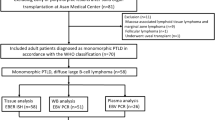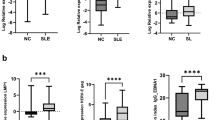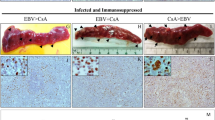Abstract
Primary effusion lymphoma (PEL) selectively involves the serous body cavities, occurs predominantly in immunodeficient patients and is infected consistently by human herpesvirus type-8. PEL is also frequently infected by Epstein–Barr virus (EBV). The precise pathogenetic role of EBV coinfection in PEL is not fully understood. The lymphoma fails to express the EBV transforming proteins EBNA-2 and LMP-1, whereas it expresses EBNA-1 (latency I phenotype). Some studies have hypothesized that other EBV-positive lymphomas expressing the latency I phenotype may associate with specific molecular variants of EBNA-1, although this issue has not been addressed in PEL. On this basis, this study is aimed at a detailed molecular characterization of EBV in PEL. Fifteen EBV positive PEL (12 AIDS-related, one post-transplant, two arising in immunocompetent hosts) were subjected to molecular characterization of the viral genes EBNA-1 and LMP-1, as well as definition of EBV type-1/type-2. The EBNA-1 gene displayed a high degree of heterogeneity in different cases of PEL, with seven distinct recognizable variants and subvariants. A wild-type LMP-1 gene was detected in 10/15 cases, whereas in 5/15 cases the LMP-1 gene harbored a deletion spanning codons 346–355. EBV type-1 occurred in 11/15 PEL whereas EBV type-2 occurred in 4/15 cases. Despite a high degree of genetic variability of the virus in different PEL cases, each single PEL harbored only one EBV variant, consistent with monoclonality of infection and suggesting that infection preceded clonal expansion. Overall, our results indicate that: (1) individual PEL cases consistently harbor a single EBV strain; (2) EBNA-1 displays a high degree of heterogeneity in different PEL cases; (3) no specific EBV genotype preferentially associates with PEL.
This is a preview of subscription content, access via your institution
Access options
Subscribe to this journal
Receive 12 print issues and online access
$259.00 per year
only $21.58 per issue
Buy this article
- Purchase on SpringerLink
- Instant access to full article PDF
Prices may be subject to local taxes which are calculated during checkout



Similar content being viewed by others
References
Cesarman E, Chang Y, Moore PS, Said JW, Knowles DM . Kaposi's sarcoma-associated herpesvirus-like DNA sequences in AIDS-related body-cavity-based lymphomas New Engl J Med 1995 332: 1186–1191
Gaidano G, Pastore C, Gloghini A, Cusini M, Nomdedeu J, Volpe G, Capello D, Vaccher E, Bordes R, Tirelli U, Saglio G, Carbone A . Distribution of human herpesvirus-8 sequences throughout the spectrum of AIDS-related neoplasia AIDS 1996 10: 941–949
Nador R, Cesarman E, Chadburn A, Dawson DB, Ansari MQ, Said J, Knowles DM . Primary effusion lymphoma: a distinct clinicopathologic entity associated with the Kaposi's sarcoma-associated herpes virus Blood 1996 88: 645–656
Karcher DS, Alkan S . Human herpesvirus-8-associated body cavity-based lymphoma in human immunodeficiency virus-infected patients: a unique B cell neoplasm Hum Pathol 1997 28: 801–808
Jones D, Ballestas ME, Kaye KM, Gulizia JM, Winters GL, Fletcher J, Scadden DT, Aster JC . Primary-effusion lymphoma and Kaposi's sarcoma in a cardiac-transplant recipient New Engl J Med 1998 339: 444–449
Dotti G, Fiocchi R, Motta T, Facchinetti B, Chiodini B, Borleri GM, Gavazzeni G, Barbui T, Rambaldi A . Primary effusion lymphoma after heart transplantation: a new entity associated with human herpesvirus-8 Leukemia 1999 13: 664–670
Jaffe ES . Primary body cavity-based AIDS-related lymphomas. Evolution of a new disease entity Am J Clin Pathol 1996 105: 141–143
Otsuki T, Kumar S, Ensoli B, Kingma DW, Yano T, Stetler-Stevenson M, Jaffe ES, Raffeld M . Detection of HHV-8/KSHV DNA sequences in AIDS-associated extranodal lymphoid malignancies Leukemia 1996 10: 1358–1362
Gessain A, Briere J, Angelin-Duclos C, Valensi F, Beral HM, Davi F, Nicola MA, Sudaka A, Fouchard N, Babarre J, Troussard X, Dulmet E, Audouin J, Diebold J, de Thé G . Human herpes virus 8 (Kaposi's sarcoma herpesvirus) and malignant lymphoproliferations in France: a molecular study of 250 cases including two AIDS-associated body cavity based lymphomas Leukemia 1997 11: 266–272
Uphoff CC, Habig S, Carbone A, Gaidano G, Drexler HG . HHV-8 infection is specific for cell lines derived from primary effusion (body cavity-based) lymphomas Leukemia 1998 12: 1806–1809
Jaffe ES, Harris NL, Diebold J, Muller-Hermelink HK . World Health Organization classification of neoplastic diseases of the hematopoietic and lymphoid tissues. A progress report Am J Clin Pathol 1999 111: (Suppl. 1) S8–S12
Horenstein MG, Nador RG, Chadburn A, Hyjek EM, Inghirami G, Knowles DM, Cesarman E . Epstein–Barr virus latent gene expression in primary effusion lymphomas containing Kaposi's sarcoma-associated herpesvirus/human herpesvirus-8 Blood 1997 90: 1186–1191
Chang Y, Moore PS, Talbot SJ, Boshoff CH, Zarkowska T, Godden-Kent D, Paterson H, Weiss RA, Mittnacht S . Cyclin encoded by KS herpesvirus Nature 1996 382: 410
Moore PS, Boshoff C, Weiss RA, Chang Y . Molecular mimicry of human cytokine and cytokine response pathway genes by KSHV Science 1996 274: 1739–1744
Ruf IK, Rhyne PW, Yang H, Borza CM, Hutt-Fletcher LM, Cleveland JL, Sample JT . Epstein–Barr virus regulates c-MYC, apoptosis, and tumorigenicity in Burkitt lymphoma Mol Cell Biol 1999 19: 1651–1660
Komano J, Sugiura M, Takada K . Epstein–Barr virus contributes to the malignant phenotype and to apoptosis resistance in Burkitt's lymphoma cell line Akata J Virol 1998 72: 9150–9156
Kube D, Vockerodt M, Weber O, Hell K, Wolf J, Haier B, Grasser FA, Muller-Lantzsch N, Kieff E, Diehl V, Tesch H . Expression of Epstein-Barr virus nuclear antigen 1 is associated with enhanced expression of CD25 in the Hodgkin cell line L428 J Virol 1999 73: 1630–1636
Wilson JB, Bell JL, Levine AJ . Expression of Epstein-Barr virus antigen-1 induces B cell neoplasia in transgenic mice EMBO J 1996 15: 3117–3126
Rowe M, Rowe D, Gregory C, Young L, Farrel P, Rupani H, Rickinson A . Differences in B cell growth phenotype reflect novel patterns of Epstein–Barr virus latent gene expression in Burkitt lymphoma cells EMBO 1987 6: 2743–2751
Klein G . Viral latency and transformation: the strategy of Epstein–Barr virus Cell 1989 58: 5–8
Rickinson AB, Kieff E . Epstein–Barr virus. In: Fields BN (ed) Virology Lippincott-Raven: Philadelphia 1996 pp 2397–2404
Bhatia K, Raj A, Gutierrez MI, Judde J-G, Spangler G, Venkatesh H, Magrath IT . Variation in the sequence of Epstein–Barr virus nuclear antigen 1 in normal peripheral blood lymphocytes and in Burkitt's lymphomas Oncogene 1996 13: 177–181
Gutierrez MI, Raj A, Spangler G, Sharma A, Hussain A, Judde J-G, Tsao SW, Yuen PW, Joab I, Magrath IT, Bhatia K . Sequence variations in EBNA-1 may dictate restriction of tissue distribution of Epstein–Barr virus in normal and tumour cells J Gen Virol 1997 78: 1663–1670
Gutierrez MI, Spangler G, Kingma D, Raffeld M, Guerrero I, Misad O, Jaffe ES, Magrath IT, Bhatia K . Epstein–Barr virus in nasal lymphomas contain multiple ongoing mutations in the EBNA-1 gene Blood 1998 92: 600–606
Triantos D, Boulter AW, Leao JC, Di Alberti L, Porter SR, Scully CM, Birnbaum W, Johnson NW, Teo CG . Diversity of naturally occurring Epstein–Barr virus revealed by nucleotide sequence polymorphism in hypervariable domains in the BamHI K and N subgenomic regions J Gen Virol 1998 79: 2809–2817
Chen Y-Y, Chang KL, Chen W-G, Shibata D, Hayashi K, Weiss LM . Epstein–Barr virus-associated nuclear antigen-1 carboxy-terminal gene sequences in Japanese and American patients with gastric carcinoma Lab Invest 1998 78: 877–882
Habeshaw G, Yao QY, Bell AI, Morton D, Rickinson AB . Epstein–Barr virus nuclear antigen 1 sequences in endemic and sporadic Burkitt's lymphoma reflect virus strains prevalent in different geographic areas J Virol 1999 73: 965–975
Chang KL, Chen Y-Y, Chen W-G, Hayashi K, Bacchi C, Bacchi M, Weiss LM . EBNA-1 gene sequences in Brazilian and American patients with Hodgkin's disease Blood 1999 94: 244–250
Cesarman E, Moore PS, Rao PH, Inghirami G, Knowles DM, Chang Y . In vitro establishment and characterization of two acquired immunodeficiency syndrome-related lymphoma cell lines (BC-1 and BC-2) containing Kaposi's sarcoma-associated herpesvirus-like (KSHV) DNA sequences Blood 1995 86: 2708–2714
Drexler HG, Uphoff CC, Gaidano G, Carbone A . Lymphoma cell lines: in vitro models for the study of HHV-8+ primary effusion lymphomas (body cavity-based lymphomas) Leukemia 1998 12: 1507–1517
Drexler HG, Meyer C, Gaidano G, Carbone A . Constitutive cytokine production by primary effusion (body cavity-based) lymphoma-derived cell lines Leukemia 1999 13: 634–640
Baer R, Bankier AT, Biggin MD, Deininger PL, Farrell PJ, Gibson TJ, Hatfull G, Hudson GS, Satchwell SC, Seguin C, Tuffnell PS, Barrell BG . DNA sequence and expression of the B95–8 Epstein–Barr virus genome Nature 1984 310: 207–211
Kingma DW, Weiss WB, Jaffe ES, Kumar S, Frekko K, Raffeld M . Epstein–Barr virus latent membrane protein-1 oncogene deletions: correlations with malignancy in Epstein–Barr virus-associated lymphoproliferative disorders and malignant lymphomas Blood 1996 88: 242–251
Klein C, Rothenberger S, Niemeyer C, Bachmann E, Odermatt B, Bohm N, Brandis M, Knecht H . EBV-associated lymphoproliferative syndrome with a distinct 69 base-pair deletion in the LMP-1 oncogene Br J Haematol 1995 91: 938–940
Khanim F, Yao Q-YY, Niedobitek G, Sihota S, Rickinson AB, Young LS . Analysis of Epstein–Barr virus gene polymorphisms in normal donors and in virus-associated tumors from different geographic locations Blood 1996 88: 3491–3501
Walling DM, Edmistan SN, Sixbey JW, Abdel-Hamid M, Resnick L, Raab-Traub N . Co-infection of multiple strains of the Epstein–Barr virus in human immunodeficiency virus-associated hairy leukoplachia Proc Natl Acad Sci USA 1992 89: 6560–6564
Yao QY, Tierney RJ, Croom-Carter D, Dukers D, Cooper GM, Ellis CJ, Rowe M, Rickinson AB . Frequency of multiple Epstein–Barr virus infections in T cell immunocompromised hosts J Virol 1996 70: 4884–4894
Sample J, Kieff E, Kieff E . Epstein–Barr virus types 1 and 2 have nearly identical LMP-1 transforming genes J Gen Virol 1994 75: 2741–2746
Miller WE, Hood Edwards R, Walling DM, Raab-Traub N . Sequence variation in the Epstein–Barr virus latent membrane protein 1 J Gen Virol 1994 75: 2729–2740
Boyle MJ, Sewell WA, Sculley TB, Apolloni A, Turner JJ, Swanson CE, Penny R, Cooper DA . Subtypes of Epstein–Barr virus in human immunodeficiency virus-associated non-Hodgkin lymphoma Blood 1991 78: 3004–3011
Goldschmidts WL, Bhatia K, Franklin Johnson J, Akar N, Gutierrez MI, Shibata D, Carolan M, Levine A, Magrath IT . Epstein–Barr virus genotypes in AIDS-associated lymphomas are similar to those in endemic Burkitt's lymphomas Leukemia 1992 6: 875–878
Menin C, Ometto L, Veronesi A, Montagna M, Coppola V, Veronese ML, Indraccolo S, Bruni L, Corneo B, Amadori A, De Rossi A, Chieco-Bianchi L, D'Andrea E . Dominance of a single Epstein–Barr virus strain in SCID-mouse tumours induced by injection of peripheral blood mononuclear cells from healthy human donors Virus Res 1995 36: 215–231
Schuster V, Ott G, Seidenspinner S, Kreth HW . Common Epstein–Barr virus (EBV) type-1 variant strains in both malignant and benign EBV-associated disorders Blood 1996 87: 1579–1585
Ometto L, Menin C, Masiero S, Bonaldi L, Del Mistro A, Cattelan AM, D'Andrea E, De Rossi A, Chieco-Bianchi L . Molecular profile of Epstein–Barr virus in human immunodeficiency virus type 1-related lymphadenopathies and lymphomas Blood 1997 90: 313–322
Dolcetti R, Quaia M, Gloghini A, De Re V, Zancai P, Cariati P, Babuin L, Cilia AM, Rizzo S, Carbone A, Boiocchi M . Biologically relevant phenotypic changes and enhanced growth properties induced in B lymphocytes by an EBV strain derived from a histologically aggressive Hodgkin's disease Int J Cancer 1999 80: 240–249
Acknowledgements
This work was supported by Istituto Superiore di Sanità, II Programma Nazionale di Ricerca sull'AIDS 1998 – Progetto Patologia, Clinica e Terapia dell'AIDS, Rome, Italy; Fondazione ‘Piera Pietro e Giovanni Ferrero’, Alba, Italy; ‘Fondazione CRT’, Torino, Italy and AIRC, Milan, Italy. DC is being supported by a fellowship from AIRC, Milan, Italy.
Author information
Authors and Affiliations
Rights and permissions
About this article
Cite this article
Fassone, L., Bhatia, K., Gutierrez, M. et al. Molecular profile of Epstein–Barr virus infection in HHV-8-positive primary effusion lymphoma. Leukemia 14, 271–277 (2000). https://doi.org/10.1038/sj.leu.2401651
Received:
Accepted:
Published:
Issue date:
DOI: https://doi.org/10.1038/sj.leu.2401651
Keywords
This article is cited by
-
KSHV/HHV8-positive large B-cell lymphomas and associated diseases: a heterogeneous group of lymphoproliferative processes with significant clinicopathological overlap
Modern Pathology (2020)
-
The sequence analysis of Epstein–Barr virus EBNA1 gene: could viral screening markers for nasopharyngeal carcinoma be identified?
Medical Microbiology and Immunology (2019)
-
Lymphomatoid Granulomatosis and Other Epstein-Barr Virus Associated Lymphoproliferative Processes
Current Hematologic Malignancy Reports (2012)
-
An unusual case of posttransplant peritoneal primary effusion lymphoma with T-cell phenotype in a HIV-negative female, not associated with HHV-8
Pathology & Oncology Research (2005)
-
Point mutations of the BCL-6 gene: clinical and prognostic correlation in B-diffuse large cell lymphoma
Leukemia (2002)



